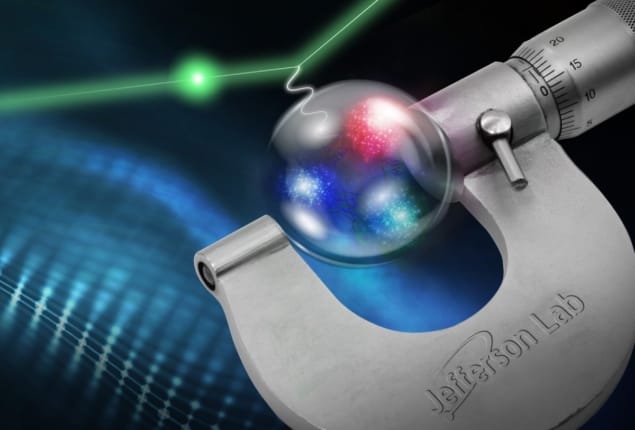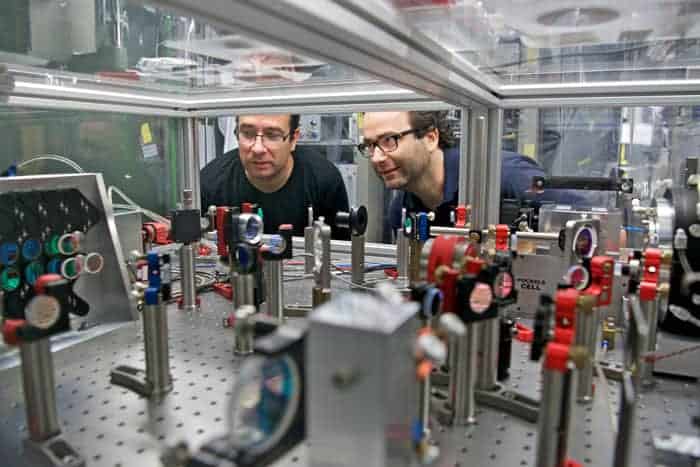
For nearly a decade the size of the particle that makes up the bulk of the universe’s visible matter has been in dispute, with experiments yielding two very different values for the radius of the proton. This disagreement may soon be resolved now that an electron scattering experiment has, for the first time, favoured the smaller of the two values.
Since the 1950s, nuclear physicists have been doing scattering experiments to measure the proton radius – or more precisely, the spatial extent of the proton’s electric charge. This involves aiming a very narrow beam of electrons at either gaseous or liquid hydrogen and measuring the tiny deflection of the electrons caused by their interaction with the hydrogen nuclei (which are protons). The idea is that the nature of the deflections reveals just how far each proton’s charge extends into space.
The proton’s size can also be gauged by measuring a feature of atomic spectroscopy called the Lamb shift. This is a minute difference in energy between two excited states of hydrogen that depends on the proton’s charge radius.
Muonic hydrogen
At the start of the 21st century, dozens of results from both types of experiment were used by The Committee on Data for Science and Technology (CODATA) to establish a very precise figure for the proton’s radius: 0.8768 fm, give or take just 0.0069 fm. But then in 2010, Randolf Pohl of the Max Planck Institute of Quantum Optics in Garching, Germany, and colleagues reported spectroscopic measurements carried out not on ordinary hydrogen but on muonic hydrogen in which the electron has been replaced by a muon.
Incredibly, the new work yielded a value of 0.84184 fm, which is nearly 4% lower than the CODATA radius. What is more, because the muon is heavier it draws closer to the proton and so undergoes a bigger Lamb shift. This increased the measurement’s sensitivity, so squeezing the error bars – to just 0.00067 fm.
The vast discrepancy with the then accepted value threw up the tantalizing possibility that some previously unknown force shaped interactions between protons and muons but not between protons and electrons. However, hopes of new physics were knocked back following spectroscopic measurements of ordinary hydrogen that yielded a proton radius consistent with that from the muonic tests – first in 2017 and then more recently in September this year. The latest work, relying on scattering rather than spectroscopy, provides independent support for the smaller radius.
Small-angle scattering
The new research has been carried out by a roughly 60-strong collaboration at the Thomas Jefferson National Accelerator Facility in the US. Collaboration leader Ashot Gasparian of North Carolina A&T State University explains that he and his colleagues replaced the magnetic spectrometer usually used in such experiments with an electromagnetic calorimeter in order to detect scattered electrons at very small angles and thereby reduce uncertainties in the measured proton radius. They also used a target chamber without windows to limit background noise and improved calibration by measuring scattering off hydrogen electrons as well as nuclei.
The measurements were made in 2016, and after a very careful analysis of the data, the team has concluded that the proton has a radius of 0.831±0.014 fm. This is consistent with the 2010 muonic hydrogen result and another muonic measurement carried out three years later, as well as the two recent hydrogen spectroscopy experiments.

Proton radius mystery deepens as deuterium measurement comes up short
Krzysztof Pachucki, a theoretical physicist at the University of Warsaw in Poland, says that the Jefferson Lab result “makes the small value of the proton radius the more likely to be the right one”. However, he says the case is not closed yet, pointing out that a group in Paris measuring the 1S-3S transition in hydrogen last year reported a radius of 0.877 ±0.013 fm – in agreement with the old value.
In fact, Gasparian maintains “it is still too early to tell” which is the true radius, insisting that more experiments are needed to settle the issue once and for all. He points out that researchers at the Paul Scherrer Institute in Switzerland are doing scattering experiments using both electrons and muons, with results, he says, due “in perhaps a year or two”. Other electron-proton scattering experiments using low-energy beams are also due to start up in Japan and France.
The research is described in Nature.



